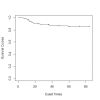Evaluation of the Factors Affecting the Cure Rate of Cervical Intra-Epithelial Neoplasia Recurrence Using Defective Models
- PMID: 34698658
- PMCID: PMC8957688
- DOI: 10.34172/jrhs.2021.56
Evaluation of the Factors Affecting the Cure Rate of Cervical Intra-Epithelial Neoplasia Recurrence Using Defective Models
Abstract
Background: Treatment of cervical intraepithelial neoplasia is very important since if it remains untreated, it may progress to cervical cancer. It is usually treated with excisional surgery. This study aimed to find the factors affecting the cure rate of cervical intraepithelial neoplasia recurrence after surgery using defective models.
Study design: A retrospective cohort study.
Methods: Excisional surgery was performed on 307 patients with high-grade cervical intraepithelial neoplasia, from 2009 to 2017. The patients were followed up until recurrence based on histopathology report. Hematologic factors were measured before surgery. The cure rates were estimated using defective models with a Gamma frailty term and the results were compared.
Results: Neutrophil-to-lymphocyte ratio (NLR) (P<0.001) and excised mass size (P<0.001) had significant impacts on cure rates, and their cut-off values were 1.9 (P<0.001) and 15 mm2 (P<0.001), respectively. Patients with lower neutrophil-to-lymphocyte ratios and larger excised tissues had higher cure rates. Defective 3-parameter Gompertz distribution with gamma frailty term had the best fit to the data, and its estimated cure rates were 98% among patients with an excised mass size of > 15 mm2 and NLR of <1.9, 84% among patients with an excised mass size of >15 mm2 and NLR of >1.9, 79% among patients with an excised mass size of <15 mm2 and NLR of <1.9, and 30% among patients with an excised mass size of <15 mm2 and NLR of >1.9.
Conclusion: Cervical intraepithelial neoplasia must be identified and treated before its progress. Excision of more tissues during excisional surgery, especially when the NLR of the patient is high, can help to prevent cervical intraepithelial neoplasia recurrence.
Keywords: Cervical intra-epithelial neoplasia; Cure rate; Defective models; Survival analysis.
Similar articles
-
Evaluation of Neutrophil-Lymphocyte Ratio as a Prognostic Factor in Cervical Intraepithelial Neoplasia Recurrence.Asian Pac J Cancer Prev. 2019 Aug 1;20(8):2365-2372. doi: 10.31557/APJCP.2019.20.8.2365. Asian Pac J Cancer Prev. 2019. PMID: 31450907 Free PMC article.
-
Incomplete excision of cervical intraepithelial neoplasia as a predictor of the risk of recurrent disease-a 16-year follow-up study.Am J Obstet Gynecol. 2020 Feb;222(2):172.e1-172.e12. doi: 10.1016/j.ajog.2019.08.042. Epub 2019 Aug 29. Am J Obstet Gynecol. 2020. PMID: 31473226
-
The Role of Neutrophil-Lymphocytes Ratio in the Prognosis of CIN2+ Recurrence after Excisional Treatment.Gynecol Obstet Invest. 2024;89(4):295-303. doi: 10.1159/000534790. Epub 2024 Mar 18. Gynecol Obstet Invest. 2024. PMID: 38498999
-
Clinical presentation, treatment, and outcomes associated with vaginal intraepithelial neoplasia: A retrospective study of 118 patients.J Obstet Gynaecol Res. 2021 May;47(5):1624-1630. doi: 10.1111/jog.14733. Epub 2021 Mar 23. J Obstet Gynaecol Res. 2021. PMID: 33754436 Review.
-
The recurrence of cervical intraepithelial neoplasia in HIV-positive women: a review of the literature.Int J STD AIDS. 2006 Aug;17(8):507-11. doi: 10.1258/095646206778145703. Int J STD AIDS. 2006. PMID: 16925893 Review.
Cited by
-
The predictive value of serum inflammatory markers for the severity of cervical lesions.BMC Cancer. 2024 Jun 28;24(1):780. doi: 10.1186/s12885-024-12561-7. BMC Cancer. 2024. PMID: 38943072 Free PMC article.
-
Associations Between Preoperative Inflammatory Indices and Residual or Recurrent Cervical Intraepithelial Neoplasia Post Loop Electrosurgical Excision Procedure.J Inflamm Res. 2024 Nov 13;17:8741-8751. doi: 10.2147/JIR.S485698. eCollection 2024. J Inflamm Res. 2024. PMID: 39559397 Free PMC article.
-
Proposal of a Risk Stratification Model for Recurrence After Excisional Treatment of High-Grade Cervical Intraepithelial Neoplasia (HG-CIN).Diagnostics (Basel). 2025 Jun 23;15(13):1585. doi: 10.3390/diagnostics15131585. Diagnostics (Basel). 2025. PMID: 40647584 Free PMC article.
References
-
- Bray F, Ferlay J, Soerjomataram I, Siegel RL, Torre LA, Jemal A. Global cancer statistics 2018: GLOBOCAN estimates of incidence and mortality worldwide for 36 cancers in 185 countries. CA Cancer J Clin. 2018;68(6):394–424. - PubMed
-
- Garcia F, Hatch KD, Berek JS. Intraepithelial Disease of the Cervix, Vagina, and Vulva. 15th ed. Berek and Novak’s Gynecology. Berek JS, editor, Philadelphia: Lippincott Williams and Wilkins 2012; p: 574-618.
-
- IARC. IARC handbooks of cancer prevention: cervix cancer screening. Vol 10. IARC Press. 2005.



